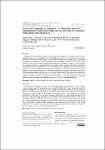Efecto del ambiente, el genotipo y la fertilidad sobre el rendimiento en grano de trigo pan y su calidad en la región subhúmeda seca pampeana
Genotypic, fertility, and environmental effects on grain yield of bread wheat and its quality in the drysubhumid pampas region
Metadatos
Mostrar el registro completo del ítemResumen
El trigo pan es importante en la región subhúmeda seca pampeana. El rendimiento en grano y su calidad muestran gran variabilidad interanual. El objetivo fue evaluar el rendimiento de grano, el peso hectolítrico y el contenido de proteína y su variación por el efecto del año, el genotipo, y la fertilidad. Los ensayos se realizaron en la Facultad de Agronomía de la UNLPam (36º 32’ 49” S ; 64º 18’ 20” W) durante 6 años, con 5 genotipos. Al tratamiento fertilizado se le agregó 100 kg.ha1 de urea al voleo en macollaje temprano. La campaña ejerció un gran efecto sobre el rendimiento. El peso hectolítrico (PH) también fue muy influenciado por el año y además por el genotipo. Sobre el porcentaje de proteína, en cambio, la fertilidad fue el factor más importante. No hubo una relación entre el grupo de calidad y el porcentaje de proteínas. El fertilizante nitrogenado en macollaje aumentó en los seis años el porcentaje de proteína, mientras que, al rendimiento solo en tres. El aumento del uso consuntivo durante el llenado de los granos provocó un aumento del PH y una disminución del contenido de proteínas en ambos tratamientos de fertilidad. El incremento de la temperatura durante el llenado disminuyó el PH y aumentó el porcentaje de proteína, solo en el tratamiento fertilizado. Bread wheat is important in the subhumid dry Pampas region. It has great interannual variability in grain yield and quality. The objective was to evaluate the effect of the year, the genotype and the nitrogen fertilization in the grain yield and its quality. The tests were carried out in the Faculty of Agronomy of the UNLPam (36º 32' 49 "S; 64º 18' 20" W) for 6 years, with 5 genotypes. The fertilized treatment was added 100 kg.ha1 of broadcast urea in early tillering. The growth season exerted a great effect on grain yield. The test weight was very influenced by the growth season and also by the genotype. On the percentage of protein, instead, fertility was the most important factor. There was no relationship between quality group and protein percentage. The nitrogen fertilizer in tillering increased the six years the percentage of protein, whereas, the yield alone in three. Increased consumptive use during grain filling caused increased test weight and decreased protein content in both fertility treatments. The increase in temperature during the filling decreased the test weight and increased the percentage of protein, only in the fertilized treatment.
Autor/a
Fernández, Miguel Angel
Osvaldo Zingaretti
Mirta Castaño
Fecha
2019Tipo de documento
artículo
dc.language.iso
spa
En: Semiárida: Revista de la Facultad de Agronomía. 2019; vol.29 no.2
Sección: Artículos Científicos y Técnicos
Extensión: p. 11-24
Palabras clave
Triticum aestivum; producción; peso hectolítrico; proteína;
Keywords
Triticum aestivum; production; test weight; protein;











